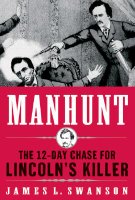Thursday, May 25, 2006
MANHUNT by James L. Swanson
 Who doesn't love a good page turner? I found one in an unlikely place: the new book by James L. Swanson, MANHUNT: THE 12-DAY HUNT FOR LINCOLN'S KILLER. It passed my "so-riveting-I-cannot-put-the-book-down-for any-reason" test.
Who doesn't love a good page turner? I found one in an unlikely place: the new book by James L. Swanson, MANHUNT: THE 12-DAY HUNT FOR LINCOLN'S KILLER. It passed my "so-riveting-I-cannot-put-the-book-down-for any-reason" test.The context of Abraham Lincoln's murder will be familiar to many readers. By April 1865, the defeat of the Confederacy was imminent. While many people were looking forward to peace, John Wilkes Booth was outraged. Booth deeply resented Lincoln even though the President's support for emancipation and black citizenship had evolved slowly.
Swanson allows readers to trail Booth as he prepares for the assassination; kills the President at Ford's Theatre; injures his leg in his famous leap onto the stage; flees the theatre on horseback; and makes his way out of the District of Columbia and into the Maryland countryside. We meet the men and women who aided Booth including such infamous "characters" as Mary Surratt and Dr. Samuel Mudd. Less well known is T. Jones, a Confederate scout and courier. He helped Booth and his companion David Herold avoid capture by hiding them in a pine thicket for several days and providing them with a boat and directions for crossing the Potomac River into Virginia. Booth and Herold made several mistakes as they inched deeper into the heart of the Confederacy. Ironically, they had to rely on a handful of African Americans for directions and transportation. Their last stop was the Garrett farm, the scene of their confrontation with manhunters from the U.S. Army.
MANHUNT may appeal more to casual readers than scholars. Still, there is much of interest in Swanson's crisp, fast-paced narrative. The author avoids any historical debates except to assert that Dr. Mudd was more closely linked to Booth than his defenders (and descendants) have claimed.
Fans of "police procedurals" will enjoy Swanson's retelling of the manhunt for Booth: the clues uncovered, the witnesses questioned, the rewards offered. One example is the story of how the cavalry unit that captured Booth initially galloped past their target.
For more information about MANHUNT, visit James L. Swanson's website.
For your consideration:
- Do you read more fiction or non-fiction? Why?
- What qualities make a non-fiction book a "good read"?
- Why do you enjoy "police procedurals? "True Crime" books?
Doris Dixon, Raleigh Branch Library
Labels: Nonfiction, Reviews by Doris Dixon


